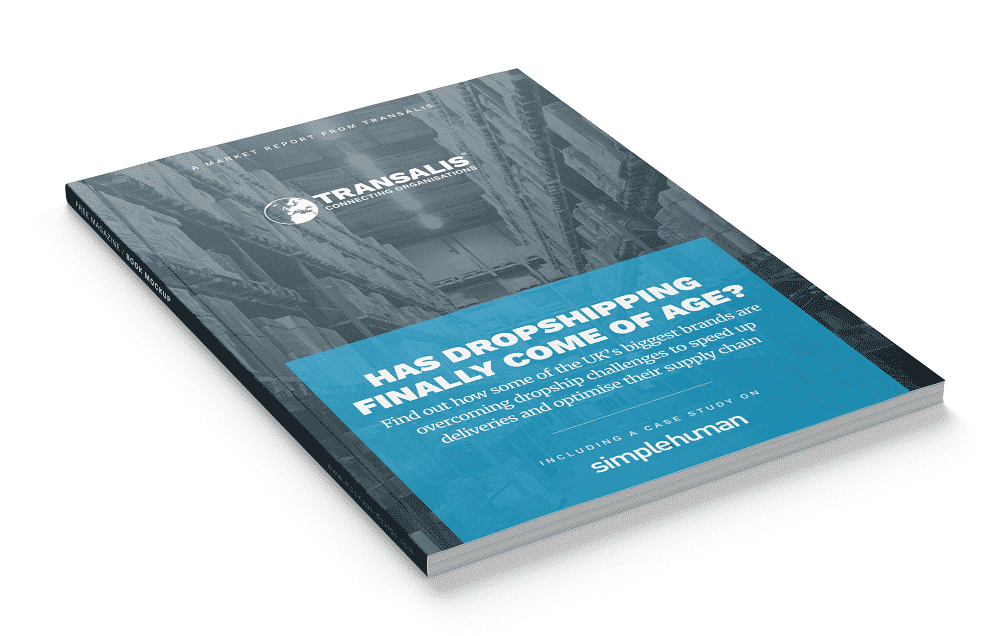Dropship EDI has the capacity to drastically improve operations for businesses starting out with, or wanting to improve, their dropship operation.
eCommerce has skyrocketed. Well over half of all consumers begin their product research online. And there’s no sign the trend will slow any time soon.
While businesses may have the warehousing capability for storing, picking and despatching stock, having suppliers who can ship directly to the customer is preferable.
Has dropshipping finally come of age?
Download the free report to find out how some of the UK’s biggest brands are overcoming dropship challenges. Including a case study from Simplehuman.
Dropship is a delivery option that’s proving advantageous for eCommerce businesses. For these retailers, it means not worrying about managing a warehouse or incurring additional carriage and fulfilment costs. Some of the UK’s biggest brands are switching to dropship and gaining a competitive advantage in the process.
However, like any other aspect of business, it’s important to ensure ROI. This means avoiding any risks of disappointing customers through poor service. In short, businesses with a dropship operation need full oversight of their dropship partner’s performance.
Without this visibility, it could be a disaster for both the bottom line and the brand’s reputation. This is where dropship EDI comes in.
What is dropshipping?
In a nutshell, dropshipping, or dropship, is a type of order fulfilment. With dropshipping, the retailer does not hold the product inventory. Instead, the retailer processes the order and passes it to a third party (such as the manufacturer) which ships the goods to the consumer directly.
What is an example of a dropshipping business?
This model was initially used by internet entrepreneurs and niche manufacturers, as a way of testing the eCommerce sales channel.
Now, many retail brands have introduced dropship to keep up with the rise of online demand. This includes Amazon, for example, which runs a vast dropshipping operation by selling products on its platform that are then fulfilled directly by the dropship partner. Although, Amazon does also hold some product lines in its warehouses, via the Amazon FBA program.
The four pillars of successful dropshipping
Many of the problems associated with dropship come down to a lack of investment and planning. There are four pillars that any business considering introducing dropship to their fulfilment strategy should carefully consider.
SHARED GOALS
Talk to your existing dropship manufacturers and create a model of supply chain management that works for both of you. Conduct due diligence on new manufacturers and make sure they share the same business ethics as you.
MAKE IT FLEXIBLE
To enable you to manage fast-changing market fluctuations, ensure the order fulfilment processes you agree with your dropship manufacturers can step up to the mark. Make sure they have the ability to meet peaks of demand.
TRUST
Once your reputation is gone, it’s difficult to get it back. Best to treat your dropshipping manufacturers as close partners, not suppliers. They hold the reputation of your company in their hands, so you need to trust them implicitly.
EFFICIENT COMMUNICATIONS
Dropship fulfilment relies on the manufacturer being connected at all times, with the ability to manage multiple discrete orders from consumers rather than bulk orders from the retailer or distributor. This means the IT systems involved must be able to fully integrate and process hundreds or even thousands of individual orders seamlessly and quickly.
eCommerce drop ship EDI with Transalis
Transalis has experience helping organisations implement dropship EDI solutions, especially for eCommerce. EDI is an agile and flexible way of ensuring a business can rapidly react to unprecedented change, such as a global pandemic or consumer trends.
Transalis dropship EDI feeds critical business data directly into internal business systems. This is facilitated by harnessing a wider set of EDI messages. With this solution tailored for retailers with dropship operations, multiple different data streams can be processed and pushed directly into the ERP, or other sales management tools, for analysis. For example, this information can include:
- Sales
- Stock levels
- Shipping status
This gives both the retailer and the dropship vendor a complete and near-immediate overview of the availability and serviceability of products. Dropship EDI provides retailers and suppliers with increased supply chain performance visibility, progress monitoring and a minimised risk of unfulfilled or delayed orders.
Transalis eDI™ Freedom allows our clients to build an entirely bespoke solution suited to their unique business needs from just £3950 per annum. This can include a large trading network of EDI connections, multiple systems integrations, and advanced reporting. Perfect for our eCommerce dropship EDI clients.
eDI Instant
As simple as 1,2,3. Buy EDI online in an instant and connect with your trading partner today
eDI Freedom
Build your own bespoke EDI solution according to your supply chain & integration needs
eDI Connect
Ideal for companies with many trading partners, high order volumes, requiring enhanced stock & sales reporting
eDI Connect+
Perfect for larger organisations requiring complete visibility across their supply chain to improve efficiencies
Related Posts
February 20, 2025
The ultimate guide to Electronic Data Interchange (EDI)
Understand how EDI works and get…
January 29, 2025
EDI in the Supply Chain: Exploring the challenges faced by food and drinks brands when supplying large retailers
Businesses that supply supermarkets and…
January 24, 2025
Why Data Visualisation is essential in ensuring an efficient supply chain
In today’s fast-paced supply chain…










